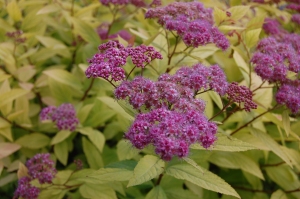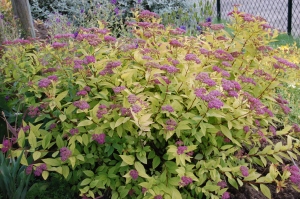Position: Flourishes in full sun.
Soil: Moist but well drained.
Flowering period: Summer.
Eventual Height: 75cm
Eventual Spread: 75cm
Hardiness: 3a, 3b, 4a, 4b, 5a, 5b, 6a, 6b, 7a, 7b, 8a, 8b, 9a
Family: Rosaceae
Spiraea japonica ‘Goldflame’ is a deciduous shrub with a clump forming habit. Its leaves are alternate, simple, ovate with toothed margins and up to 7.5cm long. They are bronze-red when young, then turn bright yellow and then mid-green. It bears pink flowers in terminal clusters.
The species Spiraea japonica, commonly known as Japanese Spiraea, is native to Japan, south west China and Korea. Of the japonica cultivars, ‘Goldflame’ was probably the first selected for coloured instead of variegated foliage. It is believed to have arisen as a branch sport of ‘Anthony Waterer’ and has continued to prove popular since its introduction over 30 years ago.
The etymological root of the binomial name Spiraea is derived from the Greek speira ‘a wreath’. Japonica is derived from the Latin meaning ‘of or from Japan’. ‘Goldflame’ is in reference to the coloured foliage.
The landscape architect may find Spiraea japonica ‘Goldflame’ is useful as an effective low ground cover low maintenance plant. Its low height makes this plant useful for planting under windowsills.
Spiraea japonica ‘Goldflame’ will tolerate almost any soil conditions; it will be happy in acid, neutral or alkaline pH levels, in loam, sand, clay or chalk and facing any aspect in a sheltered or exposed location.
Ecologically, Spiraea japonica ‘Goldflame’ is valuable as it attracts bees and other nectar loving insects during it flowering period.
The Royal Horticultural Society have given Spiraea japonica ‘Goldflame’ their prestigious Award of Garden Merit.
Spiraea japonica ‘Goldflame’ requires little maintenance. It can be pruned to near ground level after flowering to encourage new shoots and encourage a formal habit.






Leave a comment